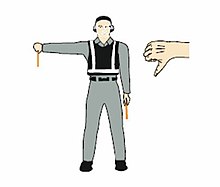Wink
Einwinkzeichen ( English : Marshalling Signals ; French : Signaux de circulation au sol ) are standardized hand signals for non-verbal communication on airfields and landing / take-off sites.
Legal basis
In the European Union the Einwinkzeichen among other things, was to standardize Implementing Regulation (EU) no. 923/2012 (short English Standardized European Rules of the Air , SERA ) from the European Commission adopted. In accordance with Appendix 1 of this Implementing Ordinance, these hand signals can be divided into winking signals and standard signals for emergency situations . The Implementing Regulation (EU) No. 923/2012 standardizes how the previously existing ICAO obligations are to be implemented within the Single European Sky.
The signals in air traffic are regulated in Appendix 1 of the SERA regulation (SERA VO). A distinction is made between
- Emergency signals (Appendix 1, Point 1.2),
- Urgency signals (Appendix 1, Section 1.3) and
- Warning signals (Appendix 1, Point 2) or
- Signals for airfield traffic (Appendix 1, point 3). The signals for airfield traffic are in turn divided into:
- Light and fireworks signals (Appendix 1, Section 3.1),
- Ground signals (Appendix 1, Section 3.2) and the
- Wink sign (Appendix 1, Point 4),
- Standard signs for emergency situations (Appendix 1, point 5).
Wink
Wink signals according to Appendix 1, Item 4 of the SERA regulation are hand signals for non-verbal communication. These are divided into angle symbols, the
- from the marshaller to the aircraft (Appendix 1, Item 4.1),
- are given by the pilot of an aircraft to a winker (Appendix 1, Point 4.2), and
- Technical / maintenance information (Appendix 1, Section 4.3).
From the winker to the aircraft
The winking signals from the aircraft operator (ground crew) include 34 signaling signals for all aircraft, but only those that are relevant for the aircraft concerned (e.g. for helicopters) are to be used. The angle signals are to be given in the direction of view of the aircraft and in the field of vision of the pilot:
- in the case of fixed wing aircraft, in front of the left side of the aircraft,
- in the case of helicopters to be given in such a way that the pilot can best see the winker,
However, before using the hand signals, the winker must ensure that the area in which the aircraft is to be piloted is free of obstacles with which the aircraft could collide (SERA-VO, Annex 1, Point 4.1.2.).
From the pilot of an aircraft to a winker
The waving signals from the pilot to the ground staff (waving in) differ significantly from the waving signals shown on the right by the ground staff due to the limited space in the cockpit . These signals are to be used by the pilot in the cockpit in such a way that his hands are clearly visible to the winker (ground staff). If necessary, a light source must be used so that the signal from the pilot to the ground staff can be easily recognized by the person who winks in (SERA-VO, Annex 1, Point 4.2.1.).
A distinction is made between five waving signals from the pilot to the ground crew:
- Brakes are applied : arm and hand are held horizontally in front of the face; the fingers of the hand are stretched out and closed into a fist (SERA-VO, Appendix 1, Point 4.2.1.1.b).
- The brakes are released : the arm is held horizontally in front of the face; the hand is closed in a fist and is opened (SERA-VO, Appendix 1, Point 4.2.1.1.b).
- Put the brake blocks in front : The arms are stretched out to the side and crossed with the palms facing outwards in front of the face (SERA-VO, Appendix 1, Point 4.2.1.2.a).
- Remove the brake blocks : The arms are crossed in front of the face and the palms are stretched out to the side (SERA-VO, Appendix 1, Point 4.2.1.2.b).
- Ready to start the engines : The number of fingers on one hand indicates the number of the engine to be started (SERA-VO, Annex 1, Point 4.2.1.3.a).
In connection with technical / maintenance information
The standardized winking signs (see above) are only to be used if voice communication for technical / maintenance information is not possible (SERA-VO, Appendix 1, Section 4.3.1).
Standard signs for emergency situations
These four standard signs for emergency situations according to Annex 1, Item 5 of the SERA regulation are simple hand signals for communication in emergency situations between the chief of operations / the fire fighters of the rescue and fire fighting service and the flight crew and / or cabin crew. These hand signals are minimum requirements and should be given from the left front of the aircraft.
See also
- List of aviation legislation
- Regulation (EU) No. 1178/2011 - European regulations on aviation personnel
- Single European Sky
Web links
- OJ EG L 281/1 of October 13, 2012 Regulation (EU) No. 923/2012 (PDF) (SERA regulation)
literature
- Air traffic regulations in the version of March 27, 1999 ( Federal Law Gazette I p. 580 ), Annex 2 ("Signals and Signs")
Individual evidence
- ↑ Implementing Regulation (EU) No. 923/2012 of the Commission of September 26, 2012 laying down common air traffic rules and operating rules for air traffic control services and procedures and amending Implementing Regulation (EC) No. 1035/2011 and Regulations (EC) No. 1265/2007, (EG) No. 1794/2006, (EG) No. 730/2006, (EG) No. 1033/2006 and (EU) No. 255/2010. This regulation is the central set of rules for the behavior of participants in air traffic within the EASA states. This also implements the obligations of the member states towards the ICAO .
- ↑ See point 5.1 of Appendix 1 of the SERA regulation.
- ↑ www.luftrecht-online.de: Online presence of the air traffic regulations










